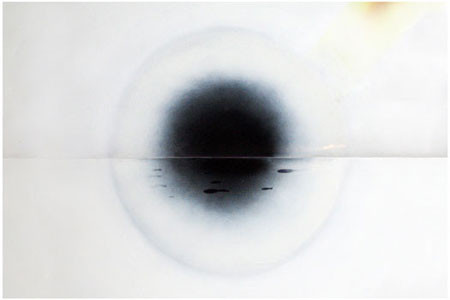Svenja Deininger
14 Sep - 11 Nov 2007
SVENJA DEININGER
"Da War Nichts"
The paintings of Svenja Deininger (b. 1974 in Vienna) are symbols of our social present. In a field of tension between concrete and abstract, they reflect the longing of modern people, who are looking for solid ground in the restless flow of time, fed by pluralism of values, individualisation and the loss of traditions. The search leads to others, who share the wish for orientation and community and ends in massively attended protective spaces of high and popular culture, creating identity and bringing pleasure at the same time, varied in kind and intensity: Salzburg/Bayreuth, Rock concert, disco, art consumption, hedonism, excess. Or else it leads to a rejection of everything secular and terrestrial, back to God and religious rituals, where it is hard to see any structural difference: the Pope is celebrated like a pop star and vice versa! This virtual exchangeability is expressed in the painting as well. It is true that some works speak a clearly religious language, such as the wall-sized work in paper, where an apparently immovable oversized eye in the night sky confronts the chaos of tumbling columns. Most pictures, however, leave the context unexplained in which the crowds of people shown, or their moving scenery, are situated. The octagonal spotlights in the upper part of “Für einen Moment war die Welt eins” (For One Moment the World was One), for example, submerge the scene in a popular-cultural light, reminiscent of concert stage lighting and a club atmosphere, but specific references are not provided. And are they actually spotlights? Or just coloured pendants to the octagons in the mid-zone of the picture? There is a pluralism of forms, colours and shape interpretations – Anything goes! – in the picture as in life. But is there a royal path? Does salvation lie in a pre-modern orientation to a divine authority or in the no less baroque pleasure of earthly joys? And: Are fulfilment, happiness and the meaning of life attainable anyway? Svenja Deininger doesn’t give a straight answer. Through emptiness and human absence (“bleu morant” and “After the pink song”) she conveys scepticism and lack of confidence, while other works have a whiff of optimism (“Für einen Moment war die Welt eins”). In her own words, Svenja Deininger is interested in the “simultaneous presence of new-start and end-of-the-world attitudes in our times”. Her painting turns this into ambigrams, which oscillate between references to these two poles of social sensitivity – sometimes pessimistic, sometimes hopeful. The search goes on.
(Text: Maximilian von Geymüller)
"Da War Nichts"
The paintings of Svenja Deininger (b. 1974 in Vienna) are symbols of our social present. In a field of tension between concrete and abstract, they reflect the longing of modern people, who are looking for solid ground in the restless flow of time, fed by pluralism of values, individualisation and the loss of traditions. The search leads to others, who share the wish for orientation and community and ends in massively attended protective spaces of high and popular culture, creating identity and bringing pleasure at the same time, varied in kind and intensity: Salzburg/Bayreuth, Rock concert, disco, art consumption, hedonism, excess. Or else it leads to a rejection of everything secular and terrestrial, back to God and religious rituals, where it is hard to see any structural difference: the Pope is celebrated like a pop star and vice versa! This virtual exchangeability is expressed in the painting as well. It is true that some works speak a clearly religious language, such as the wall-sized work in paper, where an apparently immovable oversized eye in the night sky confronts the chaos of tumbling columns. Most pictures, however, leave the context unexplained in which the crowds of people shown, or their moving scenery, are situated. The octagonal spotlights in the upper part of “Für einen Moment war die Welt eins” (For One Moment the World was One), for example, submerge the scene in a popular-cultural light, reminiscent of concert stage lighting and a club atmosphere, but specific references are not provided. And are they actually spotlights? Or just coloured pendants to the octagons in the mid-zone of the picture? There is a pluralism of forms, colours and shape interpretations – Anything goes! – in the picture as in life. But is there a royal path? Does salvation lie in a pre-modern orientation to a divine authority or in the no less baroque pleasure of earthly joys? And: Are fulfilment, happiness and the meaning of life attainable anyway? Svenja Deininger doesn’t give a straight answer. Through emptiness and human absence (“bleu morant” and “After the pink song”) she conveys scepticism and lack of confidence, while other works have a whiff of optimism (“Für einen Moment war die Welt eins”). In her own words, Svenja Deininger is interested in the “simultaneous presence of new-start and end-of-the-world attitudes in our times”. Her painting turns this into ambigrams, which oscillate between references to these two poles of social sensitivity – sometimes pessimistic, sometimes hopeful. The search goes on.
(Text: Maximilian von Geymüller)

